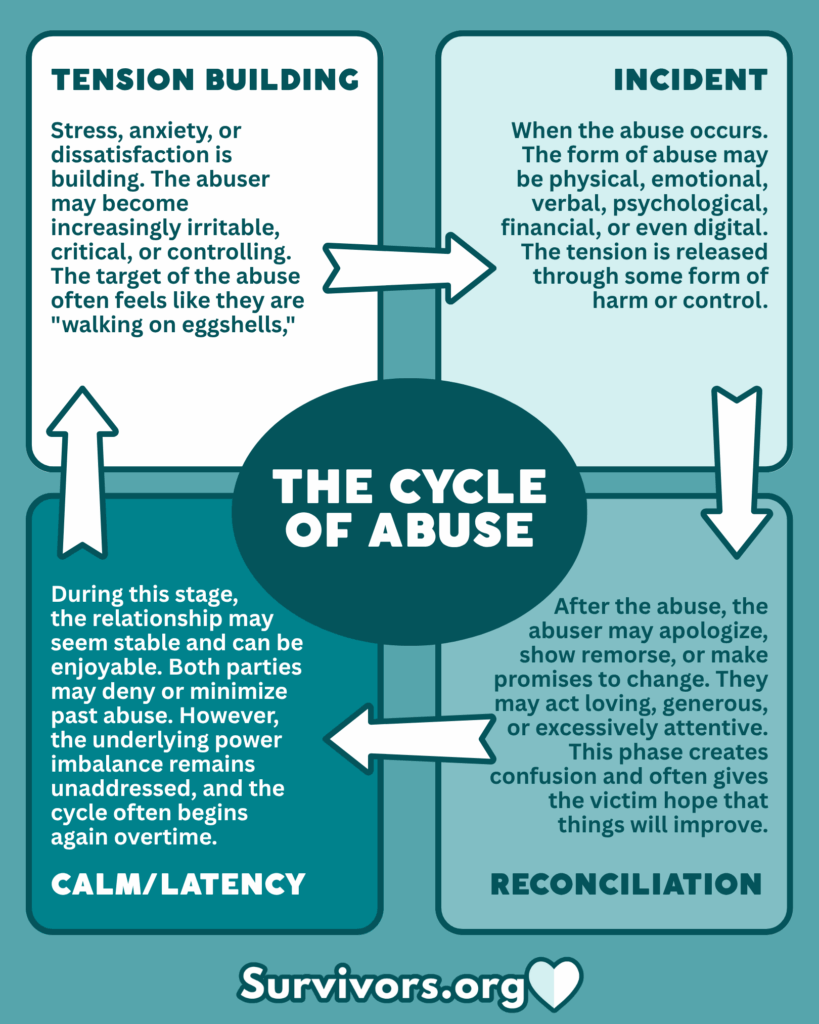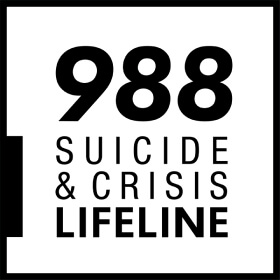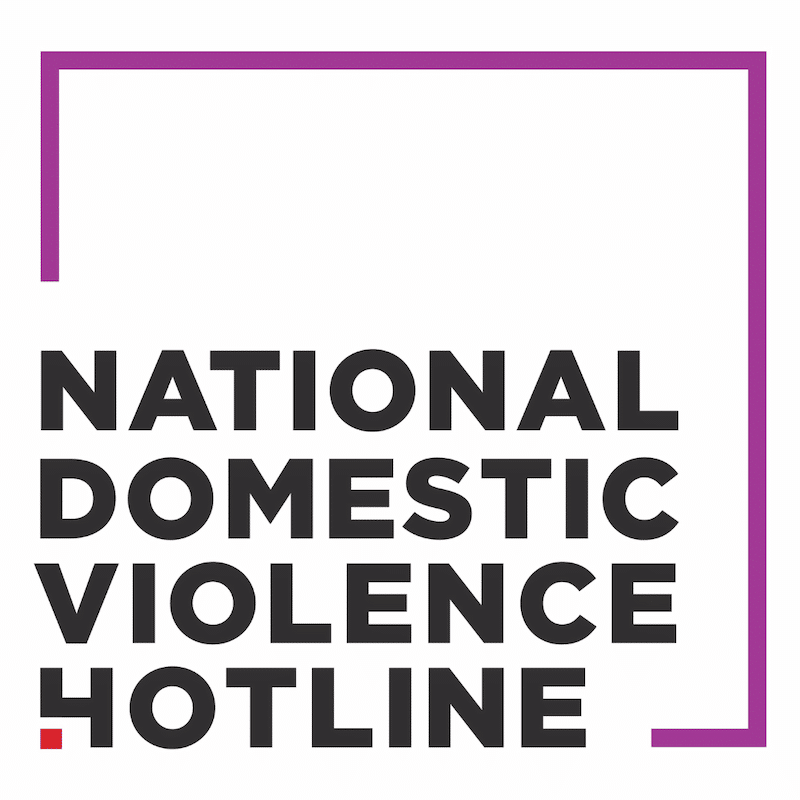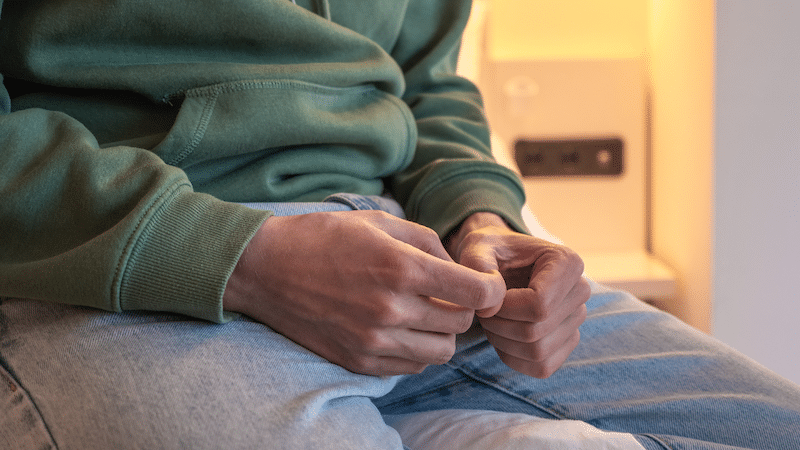The Cycle of Abuse

The cycle of abuse is a behavioral pattern that abusive individuals use (consciously or unconsciously) to maintain control and power over another person. First conceptualized by psychologist Lenore E. Walker in the 1970s based on her work with domestic violence survivors, this model has since been applied to various forms of abusive relationships beyond intimate partnerships.1
Abuse is not confined to romantic relationships. It can occur in families, friendships, workplaces, and other interpersonal dynamics. Regardless of the setting, abuse often follows a repetitive and predictable pattern known as the cycle of abuse. Recognizing this cycle is a critical step in identifying unhealthy dynamics and breaking the cycle.
Understanding The Cycle of Abuse

Phase 1: Tension building 1-5
In this stage, stress, anxiety, or dissatisfaction is building. The abuser may become increasingly irritable, critical, or controlling. The target of the abuse often feels like they are “walking on eggshells,” trying to prevent an outburst. They may internalize their inability to control the abuser, feeling shame and blame.
These are signs of tension building across relationship types, for each type of relationship these are examples of common signs. However, these signs are not exclusive to the respective relationship type.
Signs across relationship types:
- Romantic: Jealousy, silent treatment, emotional withdrawal, isolation from other relationships.
- Familial: Harsh criticisms, manipulation, mood swings.
- Friendship: Passive-aggressive behavior, guilt-tripping, being intentionally uninvited.
- Workplace: Micromanagement, unreasonable expectations, veiled threats.
Phase 2: Incident 1-5
When the abuse occurs. The form of abuse may be physical, emotional, verbal, psychological, financial, or even digital. The tension is released through some form of harm or control. These are common examples of incidents within relationships. However, these incidents are not exclusive to the respective relationship type.
Signs across relationship types:
- Romantic: Physical violence, sexual coercion, verbal degradation.
- Familial: Yelling, threats, emotional blackmail, physical violence.
- Friendship: Public humiliation, betrayal, intimidation.
- Workplace: Harassment, verbal abuse, sexual coercion.
Phase 3: Reconciliation 1-5
After the abuse, the abuser may apologize, show remorse, or make promises to change. They may act loving, generous, or excessively attentive. This phase creates confusion and often gives the victim hope that things will improve. These are examples of types of reconciliation, however, these acts are not exclusive to one particular type of relationship.
Signs across relationship types:
- Romantic: Gift giving, apologizing, affectionate, promises of getting help or going to therapy.
- Familial: Denial, rationalization, conditional love.
- Friendship: Excuses, deflection of blame.
- Workplace: Praise and favor.
Phase 4: Calm/Latency Phase 1-5
During this stage, the relationship may seem stable and can be enjoyable. Both parties may deny or minimize past abuse. However, the underlying power imbalance remains unaddressed, and the cycle often begins again overtime. This can be a longer or shorter period of calm that can vary.
Why does the cycle persist? 6
There are many reasons why an individual may choose to stay in an abusive relationship, which includes:
- Trauma bonding: Emotional attachment formed through repeated abuse and reconciliation.
- Love/remembering love: Hope for future changes and remembering the love that they once had. Feeling like you would be abandoning someone who needs you in a difficult time.
- Fear and intimidation: Threats to safety, financial security, reputation, custody over children and pets, loss of stable housing.
- Isolation: Abusers often cut off support systems, making it harder to seek help and feel accepting of help.
- Low self-esteem: Repeated abuse can damage self-worth and reinforce dependence.
- Hope for change: The calm phase aids in the belief that the abuser can or will change.
Abuse can happen to anyone, regardless of gender, sex, age, race, sexual orientation, or socioeconomic status. It can exist in any type of relationship. By broadening our understanding of how the cycle of abuse operates across various contexts, we can empower individuals to recognize the signs and take steps toward safety and healing.1-6
Here are some examples from individuals who broke the cycle of abuse in various relationship types.
If you or someone you know is caught in this cycle, know that support is available and it is possible to break the cycle.
Sources
- Walker, L. E. (2015). Looking back and looking forward: Psychological and legal interventions for domestic violence. Ethics, Medicine and Public Health, 1(1), 19-32. https://doi.org/10.1016/j.jemep.2015.02.002
- How to Support Someone Who is Experiencing Domestic Violence | RAINN. (2019). Rainn.org. https://rainn.org/news/how-support-someone-who-experiencing-domestic-violence?gad_source=1&gclid=Cj0KCQjwna6_BhCbARIsALId2Z3g-Dx6_0mkMYxoEjS28nBCyC5sfvjRF6r6I8fTAIqp3G142sGXAkQaAiuDEALw_wcB
- Holding Space: Three Ways to Support Domestic Violence Survivors. (2024, September 13). The Hotline. https://www.thehotline.org/resources/three-ways-to-support-domestic-violence-survivors/
- What If Someone You Know Is Experiencing Abuse. (n.d.). Jeanne Geiger Crisis Center. https://jeannegeigercrisiscenter.org/get-help/get-help-for-someone-else/
- Women’s aid. (2024). I’m not sure if my relationship is healthy. Women’s Aid. https://www.womensaid.org.uk/information-support/the-survivors-handbook/im-not-sure-if-my-relationship-is-healthy/
- Benedini, K.M., Fagan, A.A. A Life-Course Developmental Analysis of the Cycle of Violence. J Dev Life Course Criminology 4, 1–23 (2018). https://doi.org/10.1007/s40865-017-0073-6

988 Suicide & Crisis Lifeline
988 Lifeline is a national network of local crisis centers that provides free and confidential emotional support to people in suicidal crisis or emotional distress 24 hours a day, 7 days a week in the United States. We’re committed to improving crisis services and advancing suicide prevention by empowering individuals, advancing professional best practices, and building awareness.

Domestic Violence Hotline
We are here to serve all those impacted by relationship abuse 24/7 confidentially. Due to high demand, you may experience longer wait times to connect with a live advocate.

The Childhelp National Child Abuse Hotline
The Childhelp National Child Abuse Hotline is dedicated to the prevention of child abuse and has given assistance to more than 2 million help seekers. Serving the U.S. and Canada, the hotline is staffed 24 hours a day, 7 days a week with professional crisis counselors who—through interpreters—provide assistance in over 170 languages. The hotline offers crisis intervention, information, and referrals to thousands of emergency, social service, and support resources. All contacts are confidential.



